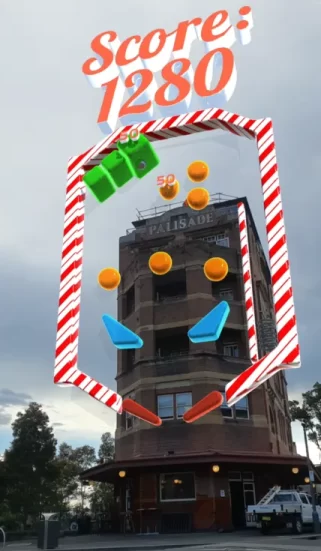Faux OOH (out-of-home) advertising is a trend that has risen to new heights in 2023. Where brands have been creating viral CGI marketing videos on social media.
What is Fake or Faux OOH?
Faux Out-of-home videos are ads that look like you would be experiencing them in the world. These are the CGI videos that combine real footage with 3D elements, that are mostly being shared on Instagram and TikTok. The footage often looks like it comes from a phone which enhances the “believability” of these Ads. In one of these clips Maybelline took over London in a way that got people wondering if the “Eyelashes are real”?
@maybelline 📣 All aboard the Sky High Mascara Express ✨🚄 After hitting the NYC Streets, we’re taking over London💂🇬🇧 We are on the move with #SkyHighMascara elevating your lash game to new heights🌤️ 🌇 it’s guaranteed to serve limitless lash length 📏 and full volume😍 #Maybelline ♬ original sound - Maybelline New York
Is this Augmented Reality?
In some of these clips there are people holding their phones as if they can see the 3D content in the world (some of them have better acting than others!). This makes it look as if it is an Augmented Reality experience, when it is infact not. This can be confusing to social media users as to what they are watching. In the clip below there are people acting as if they can see the cars in the virtual building.
Not AR!@BMW
— Declan Dwyer (@DeclanTDwyer) January 27, 2024
jumping on the faux OOH. What is faux OOH? Faux Out of Home videos are realistic looking advertising videos that make use of CGI to tell stories for a brand - in this particular video BMW is showcasing electric cars. #Advertising #NotAR pic.twitter.com/CMSzjyaF00
Could these experiences be seen in the world with Augmented Reality?
Definitely! Using location-based AR technology, it is possible to create experiences that people can engage with in the world. AR allows brands to interact with customers in the physical world with a virtual overlay.
VPS (Visual positioning systems) allow 3D content to be accurately positioned at a location in the real world, where people can come to a physical location and experience the content in AR.
Faux OOH videos can still be really engaging for social media, but with AR they can be even more fun and memorable than a short clip on TikTok.
The experience below turns a building in Sydney, Australia into an interactive pinball game using location-based AR tech.
Why not use FauxOOh and Augmented Reality?
Marketers can leverage Faux OOh and AR together to build a campaign with even higher engagement, and one that is both memorable and fun.
In Germany, Vodafone used a combination of AR experiences and social media faux OOH as part of their “Gigkombi” campaign.
The campaign recorded 17,000 minutes of active brand engagement through the WebAR experience, not even counting the additional impressions from Faux OOH videos posted on social media platforms (where it reached over 50 million people!). This indicates a significant shift in how consumers are willing to interact with brands, moving beyond passive observation to active participation.
A staggering 82% of users expressed excitement about the campaign. This level of enthusiasm underscores the potential of AR to not just capture attention but to genuinely delight and engage audiences.
Reflecting on the campaign’s call to action, an impressive 40% of participants in the OOH competition were motivated enough to visit a Vodafone store in person. This translates to a
direct and measurable impact on foot traffic, a coveted metric for any retail brand.
Looking ahead, 81% of respondents are eager to see more AR integrations in future campaigns. This forward-looking optimism highlights AR’s staying power and it’s expected to continue to be a trend in 2024 and beyond.
The campaign also revealed that users are 64% more likely to scan a QR code if it’s part of an AR experience. This statistic is particularly fascinating, suggesting that AR can significantly enhance the effectiveness of other digital marketing tools by enriching the user experience.
Finally, 67% of the consumers surveyed find AR advertising formats to be more interesting compared to traditional formats. This is a clear signal to brands and marketers about where consumer interest is heading, emphasizing the need for innovative, immersive experiences.
Augmented reality in the sky!
Using augmented reality it is possible to build interactive effects that you can see in the sky by looking through your phone.
The sky can either be replaced or you can add 3D content to the sky (or both).
Sky effects can currently be used in Snapchat and also on the web with 8th Wall. These are an out-of home style of effect that doesn’t necessarily need to be tied to a precise physical location, but instead can be used anywhere that you can see the sky!
This is #AR.
— Declan Dwyer (@DeclanTDwyer) January 27, 2024
Why use Augmented Reality?
Unlike Faux OOH videos, AR experiences are immersive and interactive.
What type of AR is this?
It is a sky effect. The sky can either be replaced or you can add 3D content to the sky (or both).
Video: @atomicsoom pic.twitter.com/ThDgwy4ffu
At Graviton we’ve used 8th Wall to bring whales to the sky.
If you would like to learn more about Faux OOH and AR, follow me on LinkedIn: https://www.linkedin.com/in/declan-dwyer/





